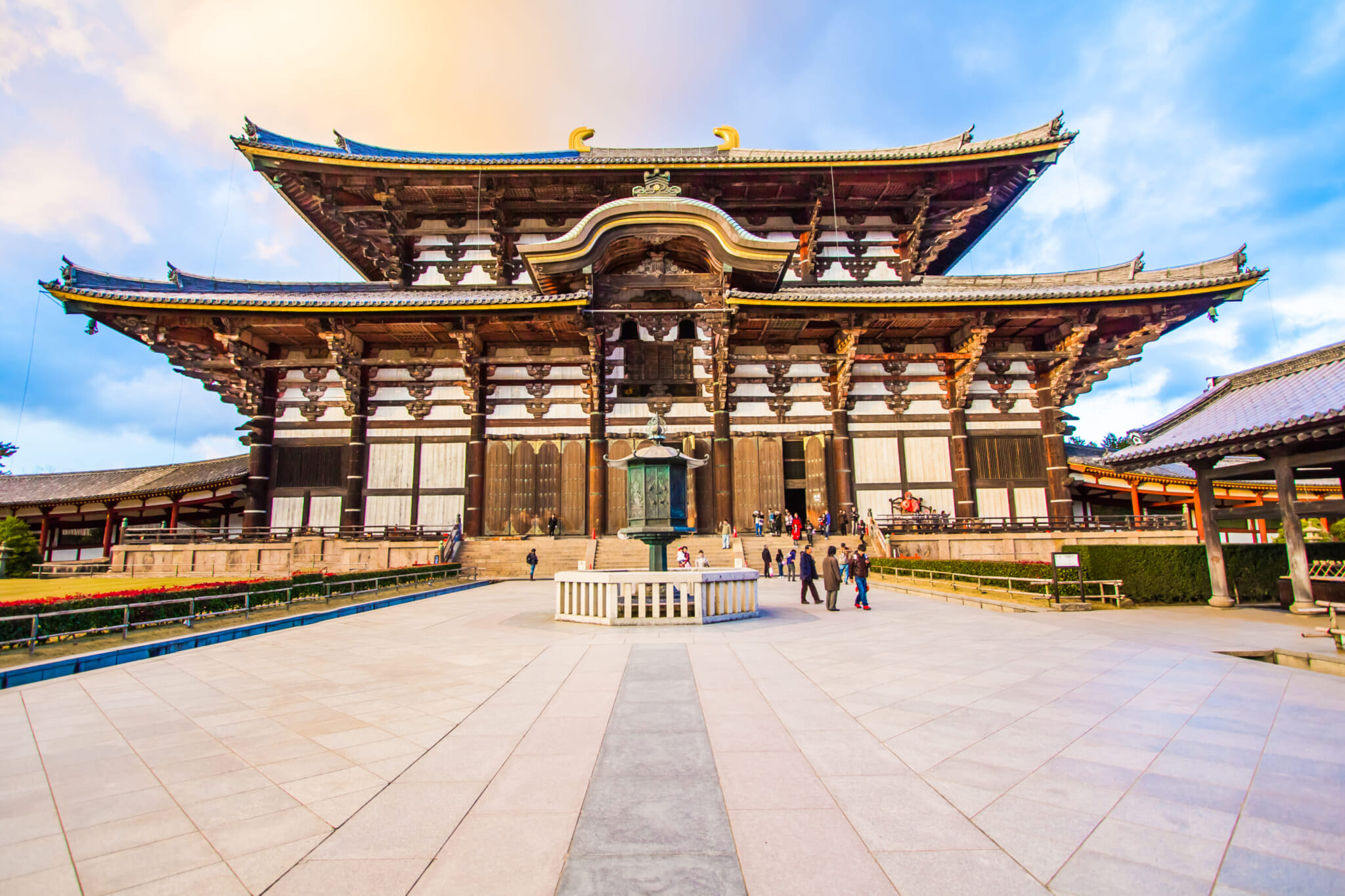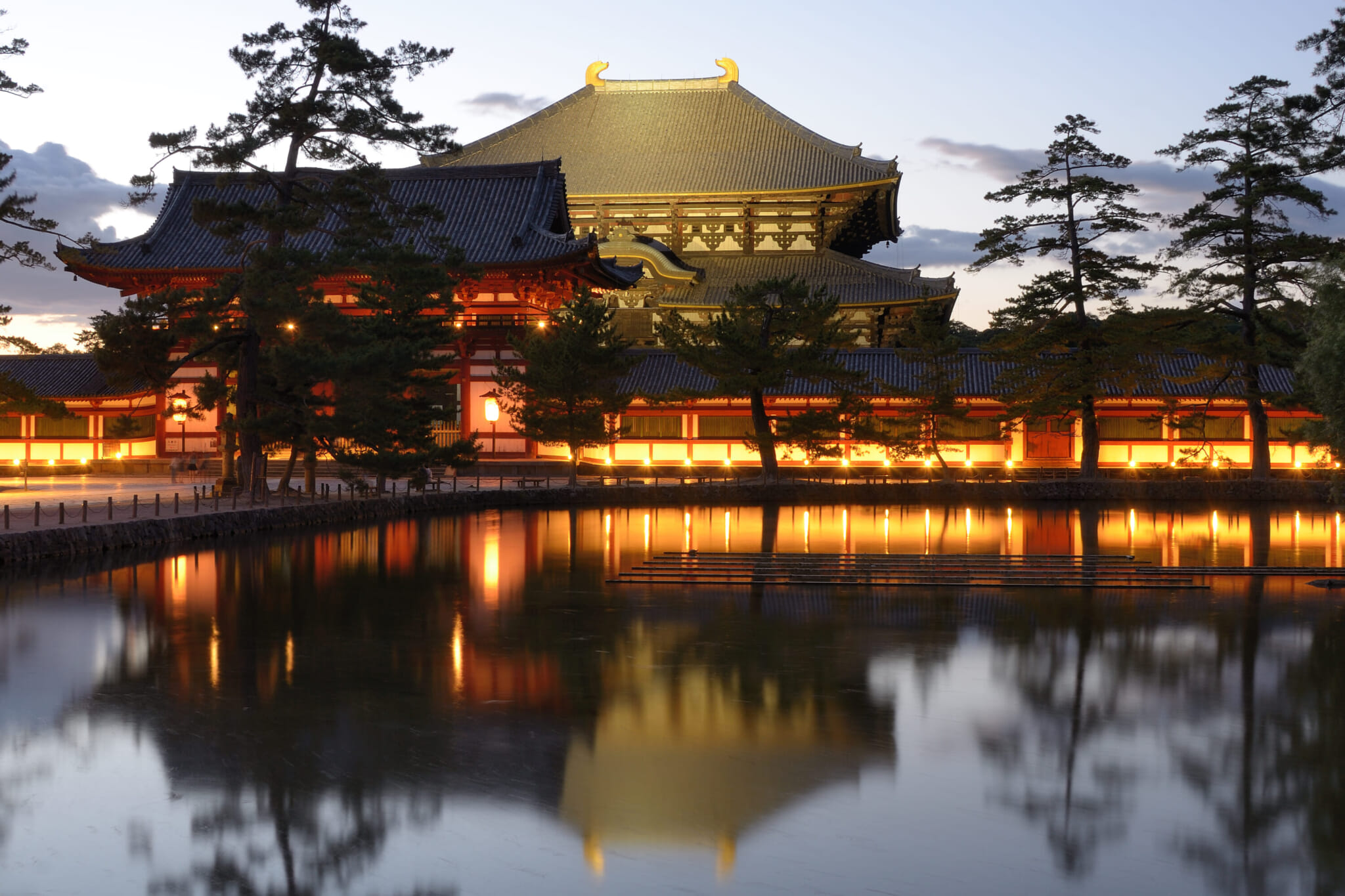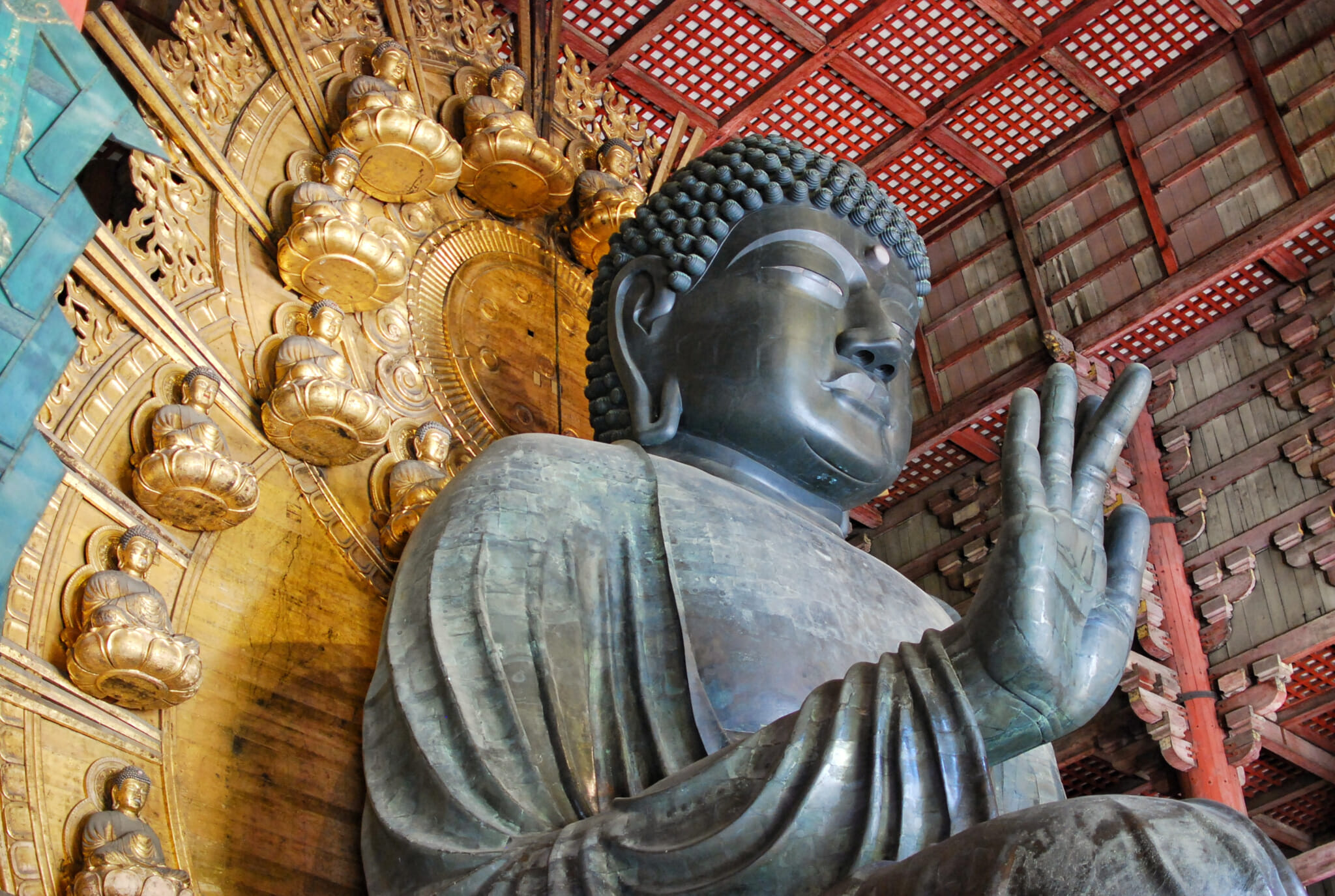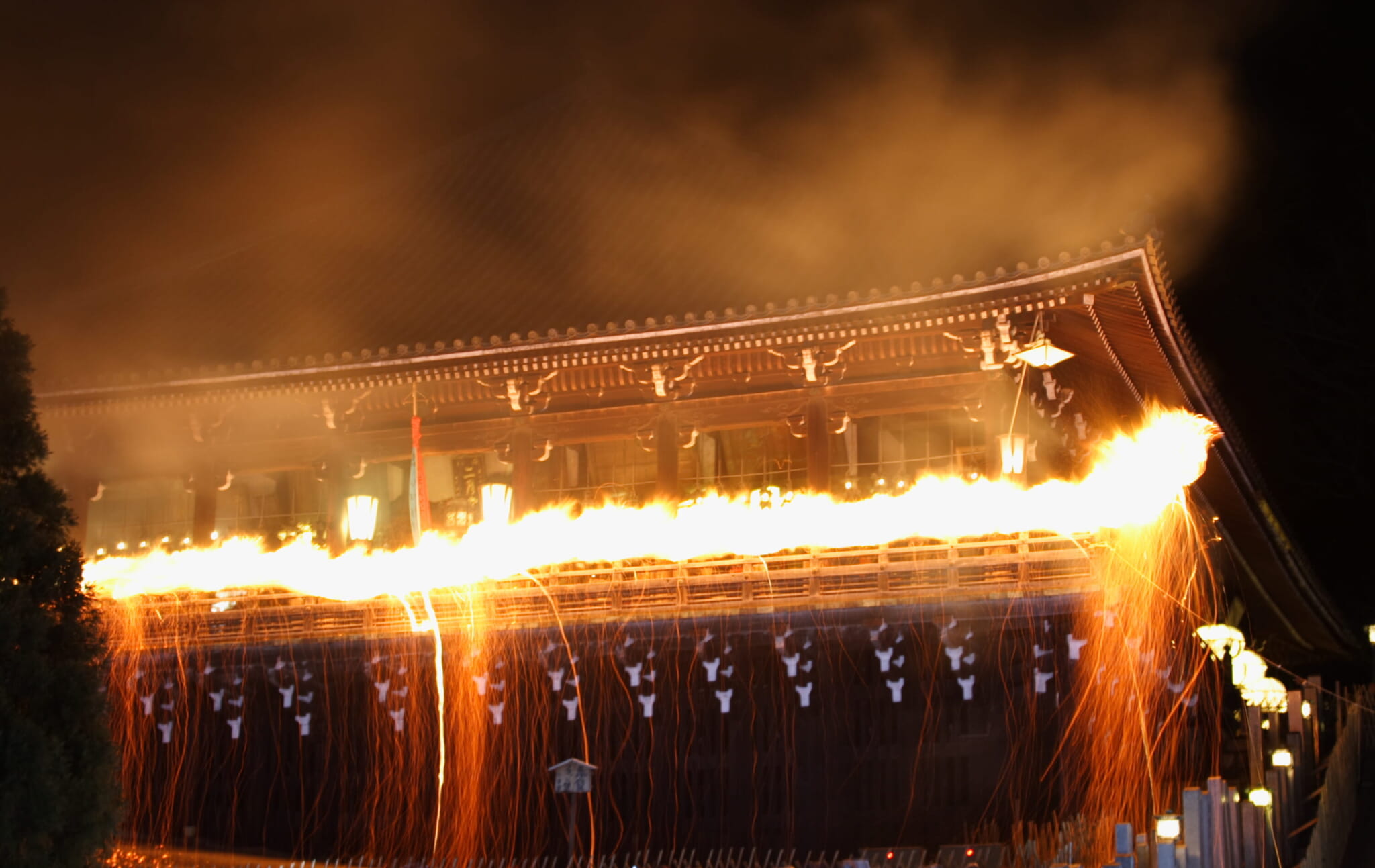One of Japan’s most famous fire festivals, Todaiji Temple’s Shuni-e is set to reopen to the public for the first time since COVID restrictions were introduced. There will be certain measures in place to ensure the safety of the audience and participants, yet the festival will remain largely unchanged. The swirling sparks and giant flaming torches are still an important fixture in the more than 1,250-year old event.
To mark the occasion, we take a look at the legendary festival and its origins.
What is the Todaiji Fire Festival?
Todaiji is a Buddhist temple in Nara Prefecture, near Kyoto. Its Shuni-e (Second Month Service) festival was established over 1,270 years ago in 752 and is famed as one of the oldest Buddhist festivals in Japan, established to pray for the security and safety of the country. During the Shuni-e ceremony, the balcony of the temple is surrounded by young monks carrying giant flaming torches in a majestic display of fire.

Todaiji Temple
Todaiji Temple is a particularly grand example of a Nara-era Buddhist temple. The exact year the temple was established is unclear, but Todaiji is a direct successor to the Kinshoji Temple, which was built in 728. Aside from its annual festivities, Todaiji is known for its 15-meter high daibutsu (large statue of the Buddha), famed as one of the oldest of its kind in Japan.
Famous Daibutsu
Kinshoji Temple was founded in 728 and in 751, work was completed on the temple’s accompanying Great Buddha Hall, celebrated with a fantastic ceremony the following year.
Since then, the hall has been subject to wear and strife. Just over 10 years after its completion, the Daibutsu was damaged in an earthquake, leading to extensive repairs. The temple also owned a lot of land, which led to it becoming the target of various attacks. In 1150 and again in 1567, the whole temple was set on fire. Nowadays, although the original temple and Daibutsu have been rebuilt many times, people visiting Nara still flock to see the site and marvel at its grandeur.

Shuni-e and Omizutori Festival
The temple hosts many events, but its most well-known is the Shuni-e, specifically one particular ceremony at midnight on March 12 (12am the morning of March 13): Omizutori. Many confuse the entire festival with the Omizutori ceremony, even though the Shuni-e lasts for 14 days.
History
Shuni-e began in the same year that the Great Buddha Hall was inaugurated, by the head priest at the time, Jitchu. It was officially a ceremony to ask the 11-headed Kannon deity for forgiveness for three sins: envy, rage and ignorance, although in reality the festival was established to please the heads of state.
Technically, the ceremony aims to ensure the security of the country, to have a fruitful harvest and to pray for the health of all its people. And, because it was a ceremony designed for the people, it was a semi-official requirement that everybody should be able to attend and enjoy it, hence the performances were devised.
Preliminary Rituals
The Shuni-e rituals are carried out by a team of monks, the members of which change every year. In total, there are 11 main monks who are involved in the ceremony from start to finish. They are referred to as Rengyoshu, comprising four senior members and seven juniors. Each has a specific role to play and all act as intermediaries between Kannon and humankind.
The rituals begin on February 18, when the oil used to burn the fire is prepared nearby, in a ceremony called Aburahakari (oil measuring). The Rengyoshu work with the local oil manufacturers to pour the oil, then measure it with a ruler to ensure there will be enough to burn for as long as the ceremony dictates, mixing different plant-based oils to create a fuel which produces minimal smoke.
On February 20, the preliminary Korro-bekka ceremony begins, during which the Rengyoshu start to clean and purify the ceremonial areas. This is followed by the So-bekka, a personal purification time, when they stay in their rooms and practice purification rituals.
The Festival Starts
Come March 1, the public ceremony begins. Each day during the two-week festival, 10 burning torches are lit (Otaimatsu), originally designed to light the way for the Rengyoshu to walk up to the temple’s Nigatsudo Hall, to complete the daily rituals. Every day, the Rengyoshu chant sutras six times during specific periods: Noon Watch, Sunset Watch, First Evening Watch, Mid-evening Watch, Latter Evening Watch, and Dawn Watch.
Omizutori Ceremony
Around midnight on the 12th day of the ceremony is the Omizutori, or “water taking.” The water is taken in honor of the god Onyu Myojin, who was late to the original ceremony over 1,000 years prior, and brought water as an apologetic offering.
It is said that, at the same time, sacred water began to spring up from a rock nearby. Today it is known as the Wakasa Well and is located below the Nigatsudo Hall on the temple site. During the ceremony, the sacred water from the well is divided between two pots: one contains water from the past 1,273 years. The other holds only fresh water. Once divvied, both pots are offered to the Kannon.

Flames and More
Otaimatsu, roughly translated, means “big pine torch.” It does what it says on the tin, with big pine torches and some added oomph, as young monks swirl the fire torches from the balcony of Nigatsudo, scattering sparks among onlookers.
In the past, this was said to bring good luck, and there were instances of crowds clamoring underneath the balcony to be hit by the showering sparks. Nowadays, however, this practice has been quashed, as onlookers stand at a safe distance from the flames, but that doesn’t make the spectacle any less impressive.
Recent Measures
In the past few decades, as media focus has been concentrated on March 12, it has become difficult to get near, or even see the torches. In 2024, as it is the first time the ceremony has been open to the public in three years, the temple strongly advises coming on a different day to experience the majesty of the 10 torches in less crowded surroundings.
The experience will be separated into two viewing points. When one becomes too crowded, spectators will be directed towards the other.









